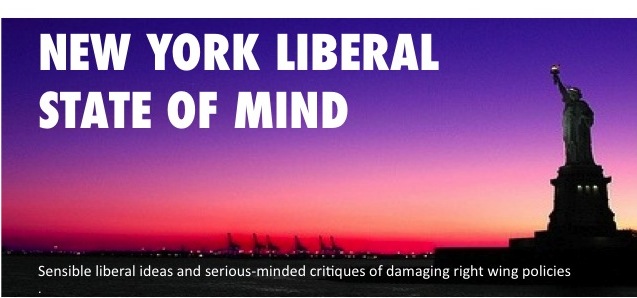In today's New York Times, David Brooks, while conflating the Tea Party "tactics" with the "New Left's" mass movement activities, literally invents history. Makes it up. Creates facts from whole cloth and ignores the core of what the New Left was all about, where it came from. (Click for his opinion piece.)
The first thing that Brooks gets wrong (please let me keep my blood pressure in check) is the difference between an organic movement and an inorganic one, or in today's parlance "grass roots" vs. "astro-turf."
The New Left flowed from many, many previous currents in American political thought, while the Tea Party has been born of money provided by the likes of the Koch Energy Corporation and Exxon Mobil in the space of a few months, and is largely a racist response to America's first African American President.
The New Left finds its roots in the Progressive Movement of the 19th century, the Suffragette efforts of the early 20th century, is connected to New Deal philosophies, Ban the Bomb protests of the 1950s and early 60s, and the Anti-Segregation battles of the 60s.
The New Left began to flower politically out of the Berkeley Free Speech Movement in the mid 1960s, and came to full fruition during the Anti-Vietnam era. While they have since taken on a life of their own, parallel to New Left politics but not entirely apart from it, the Women's Movement, the Gay Rights Movement, and the ongoing struggle for racial equality are part of the larger picture.
The New Left has also been a cultural movement through which entirely new modes of art, music, literature, architecture and cultural criticism came into being.
The New Left originally was largely a youth movement.
The New Left did not and does not despise government as a force in American society. What the New Left and its descendants and offshoots fight against are immoral, unjust or unfair features of society often created and perpetuated by government.
Unlike the right, the left does not want to dismantle government, it wants to improve it, even perfect it. Mr. Brooks must be bright enough to understand the distinction.
Were there excesses by factions associated with the New Left in its heyday? Certainly. Although significantly they were considered fringe elements by the mainstream New Left. The vast majority of protests were extremely peaceful. Some were disruptive, and a small handful were violent.
The reaction of authorities and of private citizens who were against the progressive ideas of the New Left were routinely violent and sometimes deadly. Whether it was the murder of children in a Birmingham church in 1963, the murder of innocent college students at Kent State and the murder of two students at Jackson State College in 1970, or the bloody police riots of 1968 in Chicago, the reaction was, to put it kindly, barbaric.
In retrospect, given that the Vietnam War, focal point of the New Left's outrage, ended up killing 3 to 4 million people needlessly, the efforts of the movement seem rather weak-kneed. 60,000 of our own soldiers were killed or left missing while 153,000 were wounded.
In 1967, 400,000 people marched against the war in New York. Two years later in 1969, millions of people in all parts of the country protested against the war. From 1967 through 1973, crowds of 100 to 200,000 routinely showed up in dozens of big cities, nationally and internationally. (Another point about the New Left is that it was actually the largest component of a movement that swept the whole of Western Civilization, particularly in 1968.)
The Tea Party gatherings routinely consist of crowds in the low thousands, and occasionally a crowd in the 20,000 to 25,000 range. It is not a mass movement, but a media phenomenon financed by corporate money that represents a fraction of a fraction of America's polity.
It has even gone so far as to phony up numbers and use "documentary" photos of other gatherings - most notably, ironically, of the Million Man March by African Americans in 1997 - to stretch their crowd counts, a sort of Hamburger Helper method for fringe movements. (See this analysis on PolitiFact.com.) Haven't they at least heard of Photoshop?
The Tea Party is composed mostly of older Americans. It is mostly white (another giveaway as to the racist nature of its thrust). It represents only the disgruntled middle to lower middle classes. (By contrast, the composition of the New Left is as diverse as a movement can grow.)
The Tea Party has no antecedents, unless one considers the John Birch Society and illegal citizen militias. It surely can't claim roots in Nixon's Silent Majority, which was indeed a majority and at the polling place not so silent after all. The Tea Party is more like a Vocal Mini-Minority.
The gravest distinction, which I rephrase from above, is that The Tea Party seeks to destroy government, whereas the New Left set out to eradicate genocidal policies in a pointless war, create true equal rights for all our citizens, and clean up the environment. (Sounds unsettlingly familiar to what the left seeks today, eh?)
The liberal/progressive agenda is, of course, both much broader and particularized now. At the heart of the movement lies a belief in government's potential for good, and the faith that the people can wring that good out of government.
The Tea Party gang, and much, if not the entire right wing, believes that all government is inherently evil and would return us to Thomas Hobbes's "war of all against all." You can see it in their faces. Read it in their foul posters. Hear it in the hoarse shouts of people who have stopped believing in their country.
Friday, March 5, 2010
David Brooks Invents The History of The New Left. Thanks!
Labels:
David Brooks,
Exxon,
Koch,
New Left,
New York Times,
Tea Party,
Vietnam
Subscribe to:
Post Comments (Atom)





No comments:
Post a Comment